11 Best Competitor Analysis Tools For 2024

Want to know what your competitors are up to and reverse engineer their marketing strategies? You’ll need the right competitor analysis tool for the job.
In this post, we’ll be comparing the best competitor analysis tools on the market.
These powerful software solutions enable you to track, analyze, and draw insights from your competitors’ content, SEO performance, and social profiles. You can then use this information to inform your own marketing campaigns.
Interested? Good—let’s get started!
The best SEO competitor analysis tools – summary
TL;DR
- Semrush – Best competitor analysis tool for SEO.
- Brand24 – Best for monitoring brand mentions across social media.
- Social Status – Best for monitoring your competitors’ social profiles.
#1 – Semrush
Semrush is our favorite competitor analysis tool for SEO. It’s an all-in-one digital marketing platform that comes with dozens of tools for competitor research, SEO, content marketing, PPC, and social media marketing.
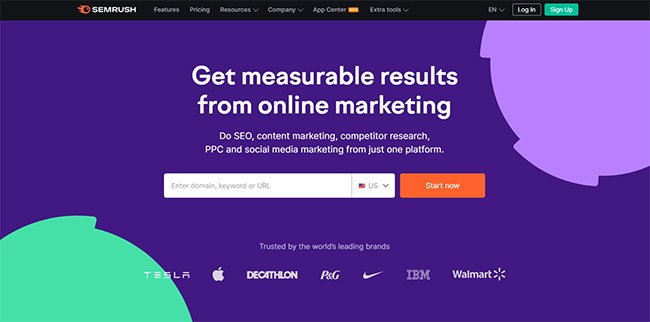
It’s one of the most popular and trusted marketing toolkits around and is used by some of the world’s biggest brands, like Samsung, Tesla, and Walmart.
The built-in competitor analysis tools enable you to explore every facet of your competitors’ digital presence. You can view detailed insights into their website traffic analytics, marketing strategies, SEO efforts, PR, and even their social media performance—all in one place.
Find out who your biggest rivals are in organic search results and discover new opportunities to compete with them. You can see information about their organic ranking position for different keywords and how this has changed all the time. Plus, find out the worth of the keywords your competitors rank for.
The keyword gaps tool lets you compare up to five competitors at once, side by side, to highlight keyword gaps that your competitors have missed. These are great search terms to target in your own SEO strategy.
The backlink analysis feature lets you see all of the referring domains pointing to your competitor’s site at a glance. You can filter the results to find those that are passing the most link juice, highlight backlinks that they’ve lost or acquired recently, and use this data to find new link-building opportunities for your own site.
Aside from that, you can also monitor mentions of your competitor’s brand name and products (as well as your own) across the web to analyze their brand sentiment and better manage your own business’s reputation.
And that’s not all! Semrush comes with a bunch of other SEO tools, including a powerful keyword research tool, on-page SEO auditor, rank tracker, link building toolkit, and more.
Key features:
- Organic competitor research
- Paid competitor research
- Competitor social media analysis
- Traffic analytics
- Backlink analytics
- Keyword research
- Keyword gap
- Rank tracking
- Content marketing tools
- Link building tools
- Content creation & optimization
- Reports
Pros:
- Most comprehensive competitor analysis toolkit on the market (with more tools/features than any of its competitors)
- Accurate and reliable data
- The largest database on the market
- Powerful keyword research & backlink analysis tool
Cons:
- Higher up-front cost than other tools (although usage limits make it more affordable than it would appear)
Pricing:
You can try out Semrush with a free account, but you’ll have limited access to the competitor analysis tools and data requests. Alternatively, you can take a free trial of their premium plans. Paid plans start from $129.95/month when you pay annually.
Read our Semrush review.
#2 – SE Ranking
SE Ranking is another awesome SEO competitor analysis tool. It’s perfect for agencies thanks to its built-in reporting and white label capabilities. But it’s also surprisingly affordable compared to other competitor analysis tools.
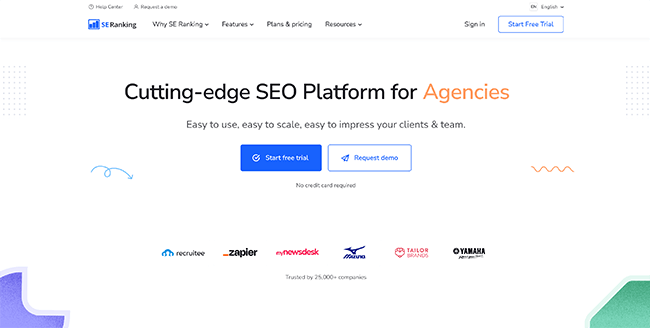
SE Ranking’s competitor analysis tool offers valuable SEO and PPC insights into your rival websites. Their keyword and backlink databases have been expanded massively in recent years.
Just enter a competitor’s URL into the SE Ranking toolbar and click Analyze to instantly get a full 360-degree view of their organic and paid search campaigns.
You can check their organic and paid traffic including the number of clicks per month, the cost of the traffic, and the keywords driving that traffic. Historical data lets you see how their traffic has changed over time and analyze whether Google algorithm updates may have affected it.
You can view a complete list of your competitors’ organic keywords alongside metrics like search volume, search rankings, difficulty, CPC, etc. Plus, evaluate their backlink profiles to find all their referring domains and visualize changes to their backlinks over time in easy-to-understand graphs.
You can also type your own domain into the search bar to find a list of your biggest PPC and SEO competitors and find any newcomers breaking into the space. Compare the performance of your site and your competitors, and discover keyword overlaps and gaps.
In addition to the competitor analysis tool, SE Ranking also offers a suite of SEO tools to help with things like rank tracking, keyword research, webpage monitoring, backlink tracking, on-page SEO optimization, and website auditing.
Key features:
- Competitor analysis
- Domain search
- Traffic analysis
- Keyword research
- Backlinks
- Global metrics
- Historical data
- Content optimization with AI writer
- PPC & SEO insights
- Benchmarking
- Keyword comparisons
Pros:
- Incredible value for money compared to other tools
- Flexible pricing plans so you only pay for what you’ll use
- Very scalable solution
- Agency-focused features like white-label options and powerful reporting
Cons:
- The entry-level plan lacks some key features like historical data
- UI is a little cluttered
Pricing:
SE Ranking offers flexible plans that start from $23.52/month, depending on your needs.
Read our SE Ranking review.
#3 – Serpstat
Serpstat is another all-in-one SEO platform with over 30 built-in digital marketing tools, including competitor analysis.
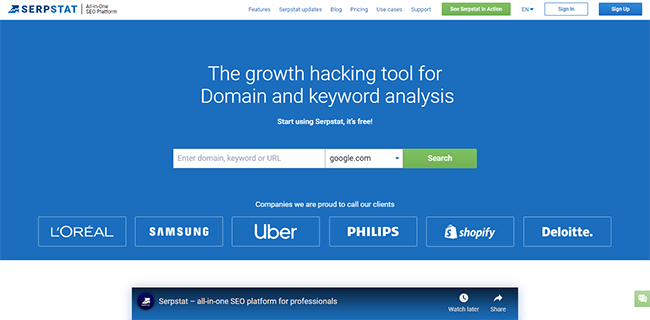
To use Serpstat for competitive research, enter your URL in their domain analysis tool. Then, navigate to the Competitors report to see a list of the websites that you’re competing with for SEO traffic.
Next to each competitor’s site, you’ll be able to see a bunch of data including their visibility score, which you can use to figure out who your biggest and smallest rivals are.
From there, click on any competitor’s website to open it up in the domain analysis tool. You’ll instantly be able to see an overview of all the most important data, including their monthly estimated search traffic, the number of organic keywords they’re ranking for, etc.
You can open up the Keywords report to see a list of all the search queries they’re ranking for. Then, sort them by traffic, ranking position, keyword difficulty, CPC, etc.
In the Domain vs Domain tool, you can compare up to three domains head to head. A bubble chart will help you to quickly visualize who has the greatest SEO visibility at a glance.
Key features:
- Competitor research
- Domain analysis
- Search traffic
- Domain vs Domain tool
- Rank tracker
- Backlink analysis
- Keywords research
- Site audit
Pros:
- Good value for money
- Lots of tools and features
- Sophisticated competitive analysis reports
- Great support team
Cons:
- Backlink database is not as big as other tools
- Visibility/traffic data is less reliable than other tools
- UX could be improved
Pricing:
You can try Serpstat out for free with limited access. Paid plans start from $45/month.
#4 – SpyFu
SpyFu is another great competitor research tool. It stands out for its excellent PPC analyzer, extensive historical data, powerful reporting, and fully-integrated outreach tools.
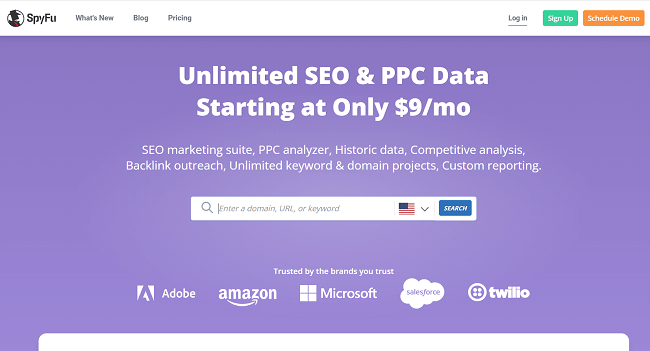
We were really impressed with the amount of information SpyFu gives you access to. It goes beyond the basic competitor analysis and lets you really zoom in on your competitors’ digital strategies. Just search for their domain to see every keyword they’ve ever ranked for or bought on Google Ads.
SpyFu offers historical data that goes back 15 years, so you can see how your competitors have performed over time.
You can also find the backlinks that are helping your competitors to rank. Then, use the integrated outreach tools to instantly find contact information (emails, phone, social profiles, etc.) for the people behind those referring domains, so you can reach out to them yourself to explore backlink opportunities for your own site.
Key features:
- Competitive analysis
- PPC analyzer
- SEO marketing suite
- Link-building/outreach tools
- Historic data
- Unlimited keyword and domain projects
- Custom reports
- SERP analysis
- Domain comparison
- Rank tracking
Pros:
- Advanced competitor analysis toolkit
- Extensive historical data
- Best-in-class PPC analysis tools
- Great for link-building campaigns
Cons:
- Free version is very limited
- Not great for local businesses
Pricing:
SpyFu usually costs $33/month (when billed annually) but they’re currently offering a lifetime discount to $8/month when you start a free trial with ClickCease. See their pricing page for more details.
#5 – Ahrefs’ Site Explorer
Ahrefs’ Site Explorer is one of the most advanced competitive research tools on the market.
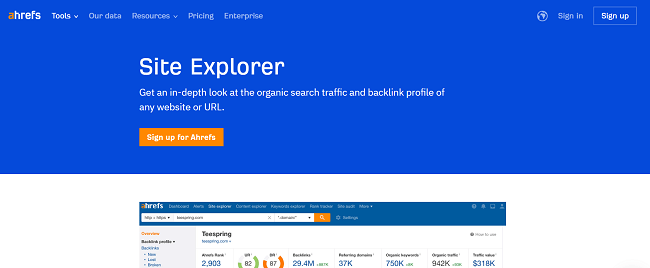
Site Explorer is one of several tools that make up the Ahrefs platform, alongside their Keywords Explorer (more on that later), Site Audit, and Rank Tracker.
Ahrefs Site Explorer gives you a wealth of data about your competitors. You can use it to dig deep into the organic search traffic, paid advertising strategy, and backlink profile of any website URL.
To start, enter your competitor’s domain in Site Explorer.
From there, you can browse the Organic search report to see what keywords they’re ranking for and how much traffic those keywords are driving. Ahrefs has a huge database of over 150 million keywords in the US, so it provides a more reliable picture of organic traffic than other tools.
Go to the Backlinks report to pull apart their link profile. This report is invaluable for planning your marketing strategy for link-building, as it can help you to find a ton of new link prospects. Ahrefs also has the world’s largest backlink index, with over 14 trillion links in its database.
To find out which of your competitors’ pages generate the most backlinks (and social shares), you can use the Pages report.
And in the Paid Search report, you can find out everything you need to know about your competitors’ PPC ads and the keywords they’re bidding on.
Key features:
- Organic search traffic
- Paid traffic research
- Backlinks report
- Pages report
- Top landing pages
- Outgoing links report
- Link intersect
- Internal backlink
- Broken links
Pros:
- Huge database and second most active crawler after Google
- Super accurate and reliable data
- Backlink analysis is best-in-class
- Proprietary metrics like Domain Rating (DR) and Ahrefs Rank
Cons:
- Not good value for money (heavy usage limits and expensive plans)
- Questionable billing practices (you may be automatically charged for overages)
Pricing:
Plans start from $83/month (billed annually). Plans start from 500 monthly credits before Ahrefs charges you for overages without warning. Those reports get used up extremely fast. No free trial is available.
Best competitor analysis tools for content
#6 – ContentStudio
ContentStudio is our top pick for the best competitive analysis tool for content marketers. It’s an all-in-one content marketing platform that you can use to spy on your competitors’ best-performing content, identify influencers in your niche, and more.
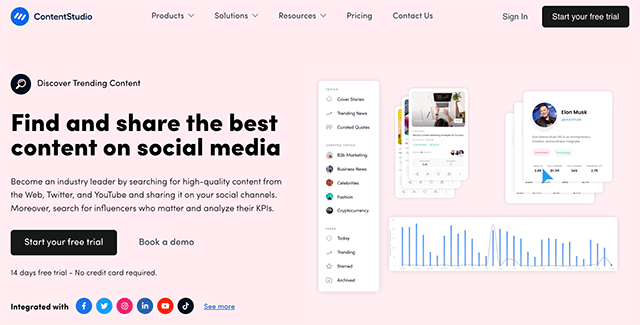
ContentStudio offers a bunch of social media related tools. But lets keep the focus on its content-focused competitor research functionality.
It’ll instantly bring up all the best-performing posts and pages on their website. Alongside each post, you’ll find a bunch of metrics that tell you how the content performs across different platforms. Sentiment analysis is included.
You can search for topics or domains. Then view the data in a content feed which will show you individual content & relevant data. There’s an insights page which will turn all of those individual pieces of content into a top-level analysis to reveal the best types of content, which platforms it performs best on, and relevant keywords, and more.
You’ll also find an influencer research database, and plenty of other features. It’s one of the best tools on this list in terms of value for money.
Key features:
- Monitoring for relevant topics
- Competitor analysis
- Influencer research
- Social publishing tools
- Competitor analytics for Instagram and Facebook
Pros:
- Extremely affordable
- Powerful research and influencer identification tools
- Additional social media tools
Cons:
- Primarily a social media tool so the competitor research tools aren’t a main focus of the tool
Pricing:
Paid plans start at $25/month. Free trial available.
#7 – Semrush Traffic Analytics
Semrush Traffic Analytics is part of the .Trends add-on for Semrush. You can use it to explore your competitors’ traffic in detail and draw strategic insights to inform your own marketing efforts.

Semrush Traffic Analytics offers an impressive amount of data. And you don’t just get access to traffic estimations for organic search. We’re talking about direct traffic, and referrals as well.
You can dig further to understand how your competitor’s traffic actually behaves. You can see metrics like average visit duration, bounce rate, device usage, and traffic sources.
You can even explore the whole user journey and find out where visitors go before and after they land on your competitors’ sites. This can help you to discover the best platforms to advertise on.
The Audience Overlap tool is another neat feature. Use it to compare audiences for up to five competitors at once and visualize the results in easy-to-understand bubble charts.
And since Traffic Analytics is part of the .Trends add-on, you also get access to the Market Explorer tool which allows you to gain better understanding of your entire market. You can see potential traffic for your entire market, and understand who the key players are at a glance. There’s also demographic data and more.
Key features:
- Traffic analytics
- Audience overlap tool
- Backlink analysis
- Competitor keyword analysis
- Reporting
- SERP position tracking
Pros:
- In-depth competitor traffic insights
- Includes advanced metrics like bounce rate, referrals, and more
- Audience overlap tool for comparing audience metrics
Cons:
- Expensive plans
- Most Semrush tools are not relevant for competitor analysis
Pricing:
Paid plans start from $99.95/month when billed annually. Add-on is available as an add-on for $200/month, and includes an additional tool – Market Explorer.
#8 – Ahrefs’ Content Explorer
Ahrefs’ Content Explorer is another feature included in the Ahrefs platform. It makes it easy to discover and analyze top-performing content related to your niche.

You can find the most popular articles on any topic with data pulled from Ahrefs’ huge database of over a billion pages.
For each article, you can see estimated monthly organic traffic, referring domains, domain rating, social shares, traffic value, etc.
You can use Content Explorer to easily find tons of great link-building prospects, partnership ideas, and ideas for low-competition topics.
You can also enter a competitor’s URL into Content Explorer to find out how often they’re republishing content and reverse engineer their strategy.
Key features:
- Content discovery
- Organic traffic estimations
- Traffic value
- Social shares
- Domain rating
- Link prospecting
- Link building
- Brand mention discovery
Pros:
- Great for finding low-competition topics
- Easy way to find the best guest blogging opportunities
- Reverse engineer your competitors’ entire content marketing strategy
Cons:
- Poor value for money
- Automatically charges you for overages without warning
Pricing:
Plans start from $83/month billed annually. No free trial. Limited usage quotas and they bill extra for overages automatically and without warning.
Best competitor research tools for social media
#9 – Social Status
Social Status is the best social media competitor research tool. Use it to analyze your competitor’s social profiles and dig into useful analytics data.
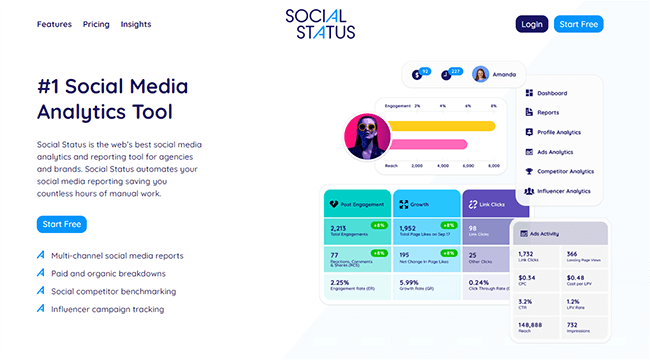
Social Status’ Competitor Analytics tool works with Facebook, Instagram, Twitter, and YouTube. You can use it to learn what’s working for your competitors, benchmark their performance, and gather strategic insights that inform your own SMM strategy.
The Content Feed shows all your competitor’s social posts in one place for you to explore. You can use filters to sort them by engagement rate, sentiment, likes, shares, etc. in order to find which ones perform best.
Discover how frequently they post and what types of media types and content themes they focus on. You can also measure their brand sentiment by tracking Facebook Reactions to their posts, and more.
Key features:
- Profile analytics
- Competitor analytics
- Reporting
- Ad analytics
- Influencer insights
Pros:
- Great for analyzing social media competitors
- Works with Facebook, Instagram, Twitter, and Youtube
- Monitor sentiment, engagement rate, and more
Cons:
- No social media management tools included
- No mentions tracking
Pricing:
You can try Social Status out with a limited free account. Paid plans start at $26/month (billed annually) and a 14-day trial is available.
#10 – Brand24
Brand24 is a powerful social media monitoring tool. Use it to monitor your brand mentions and ‘listen in’ to conversations about your brand or your competitors across social media.
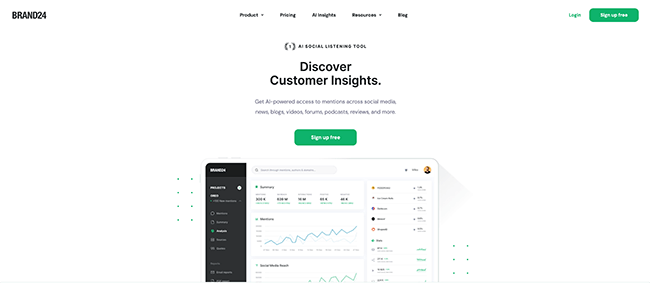
You can use Brand24 to track social mentions of any keyword, including your competitor’s brand name, product name, or hashtags. Automated sentiment analysis analyzes comments to detect positive, negative, or neutral mentions of these keywords, and uses this to give you an idea of overall sentiment.
By keeping track of conversations about your competitors on social media, you can discover useful insights. For example, you can find out who their biggest brand ambassadors and influencer partners are (and see if you can utilize them for your own campaigns), identify their weak points, etc.
Of course, you can also use Brand24 to track brand mentions for your own company. It notifies you when it detects a negative mention, so you can react quickly and protect your online reputation.
Key features:
- Mentions feed
- Sentiment analysis
- Discussion volume chart
- Marketing Analytics
- Influencer scoring tool
Pros:
- Track mentions for your own brand and your competitors
- Benchmark brand sentiment against your competitors
- Detailed and useful analytics metrics
Cons:
- Limits on mentions tracking
- No free plan is available
Pricing:
Plans start at $49/month, billed yearly. You can get started with a free trial.
Read our Brand24 review.
#11 – Social Blade
Social Blade is a powerful social media analytics platform. Use it to track your competitor’s growth on YouTube, Twitch, Instagram, and Twitter.
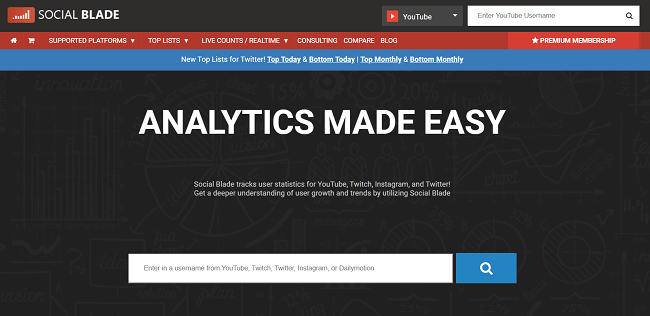
It’s easy to use and the interface couldn’t be more intuitive. All you have to do is type your competitor’s user name in and click search. Social Blade will bring up a list of their profiles on YouTube, Twitch, Instagram, and Twitter.
Next, click the one you’re interested in tracking to open up a detailed summary of all the most important data.
For example, if you’re analyzing a competitor’s YouTube channel, you’ll be able to see their subscriber growth and video views in the last 30 days, estimated monthly and yearly earnings, overall rank based on video views and subscribers, and more.
Key features:
- Analytics for YouTube, Twitter, Twitch, Instagram, and more
- Key metrics like followers gained and total views and subscribers
- Creator grading system
- Estimated earnings metrics
- Real-time subscriber counts
- Future projections tool
Pros:
- Free tool
- Easy to use
- Detailed competitor analytics
Cons:
- Limited metrics available
- No competitor tracking features
Pricing:
You can use Social Blade for free. Premium memberships start at $3.34/month (billed yearly).
Competitor analysis tools FAQ
What is competitor analysis?
Competitor analysis is the process of researching your competitors to gain insights into their strengths, weaknesses, and marketing strategies.
Within the framework of SEO (Search Engine Optimization), this usually means looking at the other websites in your niche that you compete with for sales and website traffic to evaluate their performance in search.
What can you learn from competitor analysis?
There’s a lot you can learn from competitor analysis. It shows you what other businesses and websites in your industry are doing to attract and retain customers. You can learn things like:
- How much website traffic do they get?
- What keywords are they ranking for in the SERPs? And what positions are they ranking in?
- Who are their website visitors/customers?
- What keywords are they targeting in their PPC campaigns?
- What are their best-performing landing pages and content?
- Who’s linking to them?
- What is their domain authority?
- How many followers do they have on social media?
- What kind of content do they share on social media?
- What is their brand sentiment? And how does this compare to yours?
- Where are the gaps in their marketing strategy? Are there opportunities for you to fill these gaps?
You get the idea!
Why is competitive analysis important?
Competitive analysis is critical to any marketing plan and offers businesses a way to gain a strategic advantage over other businesses in their niche. Here are just a few of the reasons why it’s so important:
- It helps you to establish benchmarks. You can use competitor analysis to uncover important metrics that measure your competitors’ performance in various areas. Then, compare these against your own KPIs to see how you stack up. This will help you to know where you’re doing well and where you still need to improve.
- You can use it to find and fill gaps. Competitor research can help you to uncover gaps in your competitors’ marketing strategies. For example, it can show you relevant keywords in your niche that your competitors haven’t targeted yet.
- It helps you define your USP. Competitive research can tell you how your competitors have positioned themselves in the market, and show you their strengths and weaknesses. You can then use this information to devise your own unique selling point.
How do I do competitor analysis?
There’s a lot that goes into competitive analysis. To perform your own competitor analysis, start by thinking about your marketing goals and what you’re hoping to achieve. This will help define the scope of your analysis.
For example, if you’re solely focusing on SEO as a marketing channel, you probably won’t need to dig into your competitors’ social media profiles.
Suppose you want to unravel the full scope of your competitors’ digital strategies. In that case, you’ll likely need several tools to monitor their social media marketing, PPC advertising, SEO, and content marketing efforts.
Once you know what you’re trying to achieve, the first step is to identify your biggest competitors. Tools like Semrush, Ahrefs, and SimilarWeb can help with this.
Next, track their organic and paid (PPC) search traffic using competitor analysis tools for SEO. Uncover the ads, keywords, and pages that are driving the most page views. Also, see if you can find gaps in their strategies—are there valuable keywords they’re not bidding on or ranking for?
You’ll also want to evaluate their content marketing strategy. Use competitor analysis tools to see what types of content they post, how they format them, and how you can position yourself to stand out from the crowd.
Some questions to ask while you’re digging into the data might include:
- What are their top-performing content pieces by social shares, traffic, etc?
- Do most of your competitors’ backlinks point to a specific piece of content?
- If so, what sites are linking to them? Do you think you earn links from them too?
Finally, use social media research tools to see which social channels they’re focusing on and benchmark their performance. Are they running any Facebook ads? Which social media platforms are driving the best results for them? And how can you compete on social media?
Finding the best competitor analysis tool for your business
As you can see, there are lots of great competitive analysis tools out there—the challenge is figuring out which one is right for you and your brand.
The best competitive analysis tool for your business will depend on what you plan on using it for. Here’s what we’d recommend:
- Use Semrush for SEO competitor analysis. It goes beyond competitive intelligence – It’s an all-in-one tool that can power your entire SEO strategy.
- Check out Brand24 if you want to monitor your brand mentions across social networks.
- Use Social Status to keep track of your competitors’ social media performance.
Tip: Check out our social media statistics to see how your competitor’s social media performance stacks up against industry benchmarks.
Looking for more digital content marketing tools to complete your software stack? Check out our roundups of the best SEO tools, social media publishing tools, and content promotion tools for more ideas!
Disclosure: Our content is reader-supported. If you click on certain links we may make a commission.
